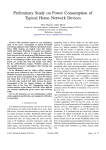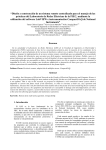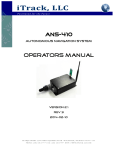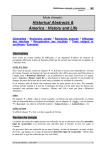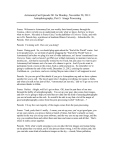Download Calibration of the Tektronix TDS 2014 Digital Oscilloscope
Transcript
Calibration of the Tektronix TDS 2014 Digital Oscilloscope Adam Black, Thuy Nguyen Centre for Advanced Internet Architectures, Technical Report 071008A Swinburne University of Technology Melbourne, Australia [email protected], [email protected] Abstract—The Tektronix TDS 2014 is a four channel Digital Storage Oscilloscope (DSO) with 8-bit analogue to digital converter. This document reports on the calibration of the equipment for voltage measurements. A precise multimeter was used to calibrate the DSO. The calibration was performed by applying various DC voltages to the DSO and comparing the measurement results reported by the DSO and the multimeter. We were able to establish a regression line for the multimeter and DSO readings, which could be used to estimate the real input voltage in future measurements recorded with the oscilloscope. We established there may be several factors which, when altered, could affect the outcome of a calibration. These factors include some of the DSO’s display settings such as the vertical position and vertical scale. Due to the results obtained, we recommend that individual calibration tests must be conducted for different DSO settings. I. I NTRODUCTION Calibration is the process of determining or rectifying the graduations of any instrument which returns quantitative measurements [1]. There are several reasons to calibrate an oscilloscope. Firstly we can improve the accuracy of measurements by justifying the oscilloscope’s output (in our case, applying a regression equation to the oscilloscope’s output to estimate the true input voltage). It is also likely that we are able reduce the manufacturer’s error specification. The report is structured as follows: Section II lists the definitions of important terms which have been used throughout the report. Section III contains the specifications of the various hardware consisting of our testbed. In Section IV the report describes how the TDS 2014 oscilloscope can be calibrated and contains the results from several calibration tests we performed. Section V investigates whether varying the vertical position of the oscilloscope can affect the consistency of voltage measurements. The report is concluded in CAIA Technical Report 071008A Section VI and the references are listed at the end of the document. II. T ERMINOLOGY This section introduces some important terminology used throughout the report. • ADC (analogue to digital converter): Converts an analogue voltage level into a discrete digital representation. The granularity of an ADC can be determined from the number of bits it uses. For example, an 8-bit ADC can digitally represent an analogue signal using 28 = 256 unique voltage levels. The more bits an ADC uses the less uncertainty exists in the digital representation. • Division: The oscilloscope’s display has a grid superimposed on the waveform display area. The vertical lines of the grid are used to represent a quantity of time and the horizontal lines are used to represent voltage levels. • Vertical scale: Measured in Volts per division, the vertical scale determines the voltage represented by a single division along the y-axis. • Vertical position: Used to offset the input of a particular channel by a fixed DC voltage. This is useful to view large voltages which would fall out of range of the screen. • Vertical resolution: The smallest distinguishable voltage increment along the vertical axis. • Regression line/Line of best fit: A mathematical equation used to represent a set of data as closely as possible. This document only discusses linear regression lines. These are lines which can be described by the equation, y = ax + b, where a and b are constants. • Coefficient of determination (R2 ) - A numerical indication of the variability between a set of data and a statistical model of the data. The coefficient October 2007 page 1 of 5 of determination can take any value between zero and one. If R2 = 1 all variability in the data set is explained in the statistical model and if R2 = 0 there is no relationship between the data set and model. III. T ESTBED S PECIFICATIONS This section will introduce the specifications of the equipment used in our calibration experiments. Tektronix TDS 2014 Digital Storage Oscilloscope: This is the oscilloscope we wish to calibrate. It has an 8-bit ADC resolution and four separate input channels. The oscilloscope has ten horizontal divisions along the y-axis and ten vertical divisions along the x-axis. Note that only eight of the ten horizontal divisions are visible on the display. The oscilloscope has a vertical position setting which allows the user to offset the input voltage by a specified quantity. If the vertical scale is configured between 2mV /div and 200mV /div the maximum configurable vertical position is ±2V . If the vertical scale is set in the range 202mV /div to 5V /div the maximum vertical position is ±50V . Instek GPC-1850D: This is used to supply a variable DC voltage to the oscilloscope. Fluke 189 digital multimeter: The multimeter is used to accurately measure the power supply’s output voltage. The multimeter has a 4 21 digit display and a DC accuracy of 0.025% + 5 digits (the error is ± 0.025% of the reading plus 5 counts of the least significant digit [2]). IV. O SCILLOSCOPE C ALIBRATION When recording quantitative measurements it is necessary to consider the potential error in the measuring devices. Manufacturers usually provide error specifications for their products but in some cases the error margin is quite conservative. By calibrating a device we can justify the accuracy of the measurements as well as produce a tighter error specification. There are several variables which may alter the outcome of a calibration test. • Vertical scale: The vertical scale determines the resolution of the oscilloscope. A large vertical scale results in low resolution voltage measurements and conversely a small vertical scale results in high resolution measurements. This means the oscilloscope’s vertical scale setting can affect the results of a calibration test. • Vertical position: In Section V we have experimentally tested whether varying the vertical position CAIA Technical Report 071008A affects the output of the oscilloscope, and therefore the results of a calibration. • Temperature: The user manual [3] recommends that the oscilloscope’s self-calibration function should be used if the ambient temperature changes by 5 ◦ C or more since the last calibration. It is recommended that the oscilloscope is recalibrated for any changes in the above variables. Measurement of a voltage range may require a particular combination of vertical scale and position settings. This section discusses the calibration process of the Tektronix TDS 2014 oscilloscope for three different voltage ranges. Similar method can be applied to other settings and measurements. A. Equipment • • • • Tektronix TDS 2014 DSO and cables. GPC-1850D Power Supply Unit (PSU). Fluke 189 digital multimeter. PC with serial port. B. Method Connect the PSU’s variable DC voltage output to the oscilloscope’s channels and the digital multimeter in parallel. Adjust the PSU to the lowest voltage level we wish to calibrate and capture a record of 2500 samples, also keep a log containing the multimeter’s reading. Increment the power supply’s voltage and repeat the acquisition process until the required range of voltages have been calibrated. Figure 1 shows the described testbed configuration. In this experiment we calibrated the oscilloscope with three different vertical positions, as displayed in Table I. These values were chosen to measure the voltage of various ADSL modems in a separate experiment. The ‘VRange ’ column displays the voltage range used to calibrate the oscilloscope for the particular vertical scale and position. The PSU was adjusted in increments of 100mV beginning from the lower bounds of VRange . For the three tests shown in Table I a timebase of 25ms/div was used. October 2007 TABLE I C ALIBRATION TEST CONFIGURATION Test 1 2 3 Vertical scale -57 -41 -43 Vertical position 300 300 300 VRange 15.5-18.5 10.8-13.8 11.4-14.4 page 2 of 5 19 DMM Reading (Volts) 18.5 18 y = 0.9945x + 0.08823 17.5 17 16.5 16 15.5 15.5 16 16.5 17 17.5 18 18.5 19 Oscilloscope CH1 Reading (Volts) Fig. 2. Fig. 1. Testbed Setup Calibration Scatter Plot - Test 1 0.015 0.01 Figure 2 shows the calibration scatter plot for Test 1 using channel one of the oscilloscope. The values along the x-axis represent the oscilloscope’s median voltage over 2500 samples and the y-axis values represent the multimeter’s reading. Under ideal circumstances the oscilloscope and multimeter readings should be identical. In reality we do not expect this to be true because both devices have some degree of error in their measurements. Tables II, III and IV display the regression equations for the tests shown in Table I. In the ‘Equation’ column the x variable represents the voltage from the oscilloscope and the y variable is the calibrated voltage. The ‘R2 ’ column contains the coefficient of determination. There are several important factors to consider when performing calibration tests, one of them is the channel used to perform the calibration. The oscilloscope has four independent input channels and they do not all have identical characteristics, therefore it is important to calibrate each channel individually. It is also reasonable to assume the regression equation is only applicable when the oscilloscope’s display settings used for voltage measurements are the same as the settings used during the calibration. In Tables II, III and IV we can see the regression equations slightly differ from the theoretical mapping, y = x. The coefficient of determination is very close to one for all the regression lines, which mean they have very strong linear correlation. The error values shown in Tables II, III and IV are CAIA Technical Report 071008A Residuals C. Results 0.005 0 −0.005 −0.01 −0.015 15.5 16 16.5 17 17.5 18 18.5 19 Oscilloscope CH1 Reading (Volts) Fig. 3. Residual Bar Plot - Test 1 TABLE II C ALIBRATION R ESULTS F ROM T EST 1 Channel 1 2 3 4 Equation: y = ax + b ± Err (Volts) y = (0.9945x + 0.0882) ± 0.015 y = (0.9963x + 0.0345) ± 0.014 y = (0.9940x + 0.1291) ± 0.013 y = (0.9924x + 0.1003) ± 0.016 R2 0.999963 0.999964 0.999980 0.999958 TABLE III C ALIBRATION R ESULTS F ROM T EST 2 Channel 1 2 3 4 October 2007 Equation: y = ax + b ± Err (Volts) y = (0.9948x + 0.0737) ± 0.013 y = (0.9965x + 0.0465) ± 0.013 y = (0.9935x + 0.1344) ± 0.014 y = (0.9927x + 0.0983) ± 0.012 R2 0.999965 0.999976 0.999954 0.999975 page 3 of 5 TABLE IV C ALIBRATION R ESULTS F ROM T EST 3 Channel 1 2 3 4 Equation: y = ax + b ± Err (Volts) y = (0.9936x + 0.0915) ± 0.012 y = (0.9970x + 0.0296) ± 0.013 y = (0.9936x + 0.1329) ± 0.014 y = (0.9918x + 0.1135) ± 0.014 for all positions up to and including -10 divisions. The testbed configuration is shown in Figure 4. R2 0.999984 0.999968 0.999950 0.999959 based on the distance between the data points and the regression line (see Figure 2). The maximum distance or residual can be used as a conservative error estimation of the regression equation. A less conservative approach may be to choose the 90th percentile of the residuals. D. Limitations and Future Work Some future work may include investigating the effects ambient temperature has upon the oscilloscope’s output. E. Conclusion V. VARYING THE V ERTICAL P OSITION The Tektronix TDS 2014 has the ability to offset an input signal in order to make large voltages visible on the screen. In this section we investigate whether varying the vertical position has any affect upon the consistency of the oscilloscope’s measurements. From this experiment we should be able to determine whether the oscilloscope needs to be calibrated for different vertical positions. • • B. Method Connect the power supply’s variable DC output to channel four of the TDS 2014 and set the output voltage to 1VDC. Configure channel four of the oscilloscope with a vertical scale of 200mV /div and set the timebase to 25ms. Adjust the vertical position to 0 divisions and capture ten records of 2500 samples, then decrease the position by one division and repeat the measurements CAIA Technical Report 071008A −5 1.08 1.06 1.04 1.02 1.00 0.98 0 −1 −2 −4 −6 −7 −8 −9 −10 Vertical Position (Divisions) Fig. 5. Tektronix TDS 2014 DSO and cables. GPC-1850D power supply. PC with serial port. −3 1.10 A. Equipment • Testbed Setup C. Results Voltage (Volts) We have demonstrated an oscilloscope can be calibrated by inputting a controlled voltage into one or more channels and recording the voltage using a precise multimeter and the oscilloscope. The multimeter voltage can then be plotted against the oscilloscope voltage and a regression equation can be formed to optimise the accuracy of future measurements. Fig. 4. Varying the Vertical Position Figure 5 shows the median voltage of 25,000 samples which were measured using channel four of the oscilloscope. The graph shows the median voltage was 0.992V when the vertical position was configured between 0 divisions and −6 divisions. When the vertical position was configured in the range −7 divisions to −9 divisions the median voltage decreased by 8mV and when the vertical position was set to −10 divisions the median voltage was 1.08V . This results suggest the consistency of the oscilloscope can be affected as the vertical position decreases. October 2007 page 4 of 5 NB: For a vertical scale of 200mV /div the maximum configurable vertical position is ±10 divisions. D. Limitations and Future Work Future work may including running similar tests using vertical scale settings other than 200mV /div E. Conclusion We found that changing the oscilloscope’s vertical position setting generally has minimal effect regarding the consistency of voltage measurements, however as the vertical position decreases (shifts further away from zero negatively) the measurements do seem to become less consistent. This result means the oscilloscope should be recalibrated for different vertical position settings. VI. C ONCLUSION In Section III we listed the various equipment consisting of the testbed. We had a Tektronix TDS 2014 oscilloscope which we wanted to calibrate, a GPC-1850D DC power supply and a Fluke 189 digital multimeter. CAIA Technical Report 071008A Section IV discussed how we calibrated the oscilloscope. The calibration was performed by connecting a DC signal into the oscilloscope and measuring the signal using the oscilloscope and a precise multimeter. The output voltage of the oscilloscope was plotted against the multimeter’s reading and a linear regression equation was fitted to the data. Section V investigated whether changing the vertical position affects the output of the oscilloscope. We found that as the vertical position decreases, the voltage measured by the oscilloscope can slightly change. To summarise, the oscilloscope should be calibrated for different vertical position settings used to record measurements. R EFERENCES [1] Dictionary.com, “Calibration,” Viewed 27 August 2007, http:// dictionary.reference.com/browse/Calibration. [2] Fluke, “Understanding specifications for precision multimeters,” http://support.fluke.com/ Viewed 08 October 2007, calibration-sales/Download/Asset/2547797 6200 ENG A W.PDF. [3] Tektronix, “TDS 1000- and TDS 2000-Series User Manual,” Viewed 24 August 2007, http://courses.washington.edu/phys334/ datasheets/Tek2kUserManual.pdf. October 2007 page 5 of 5





